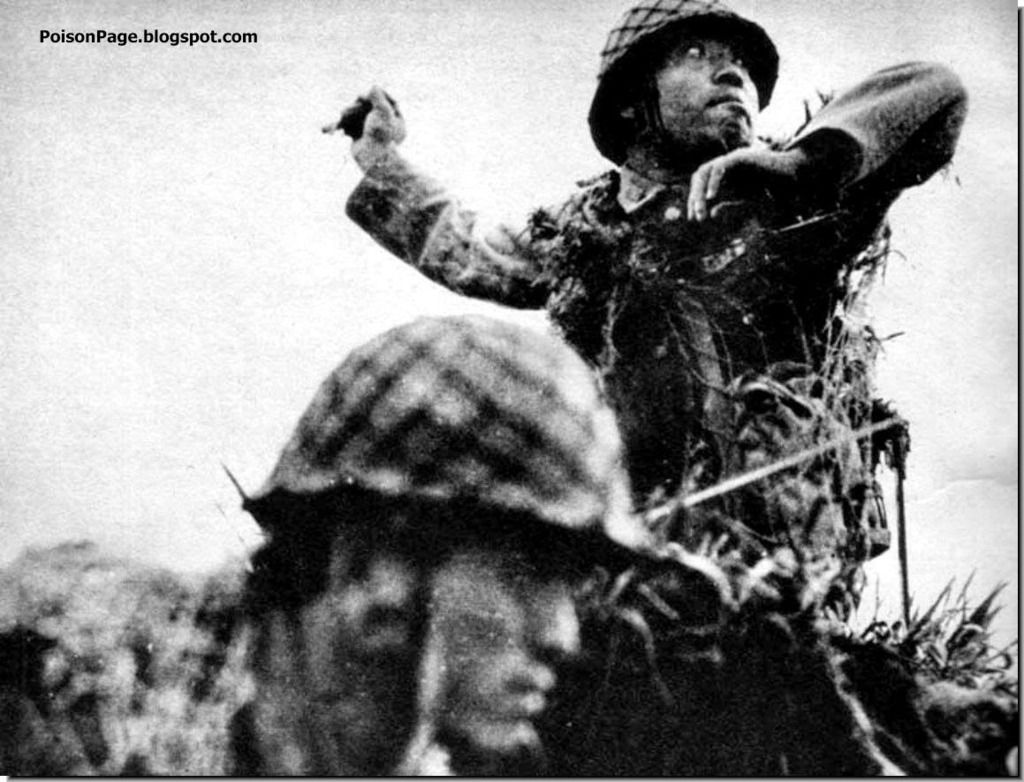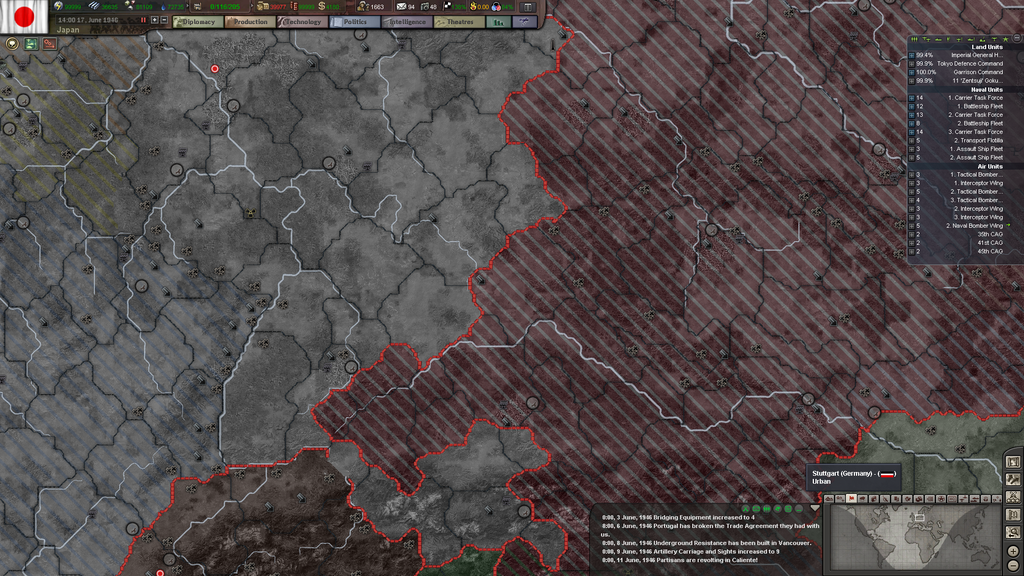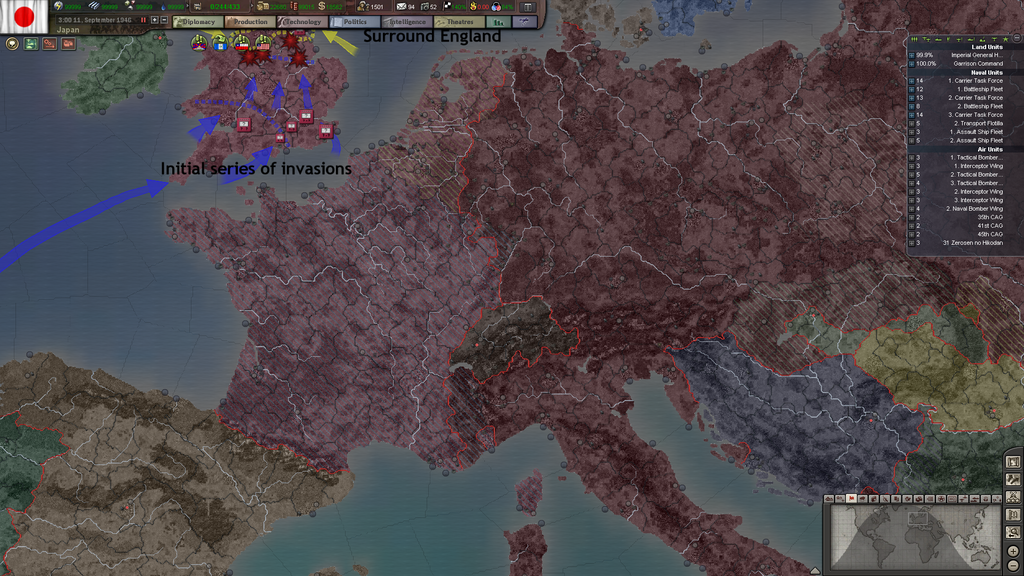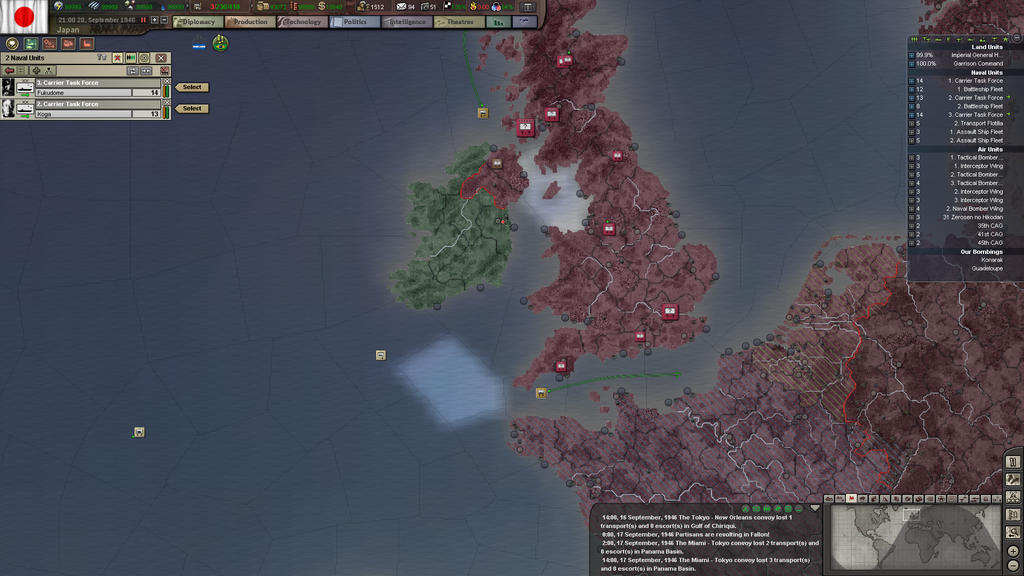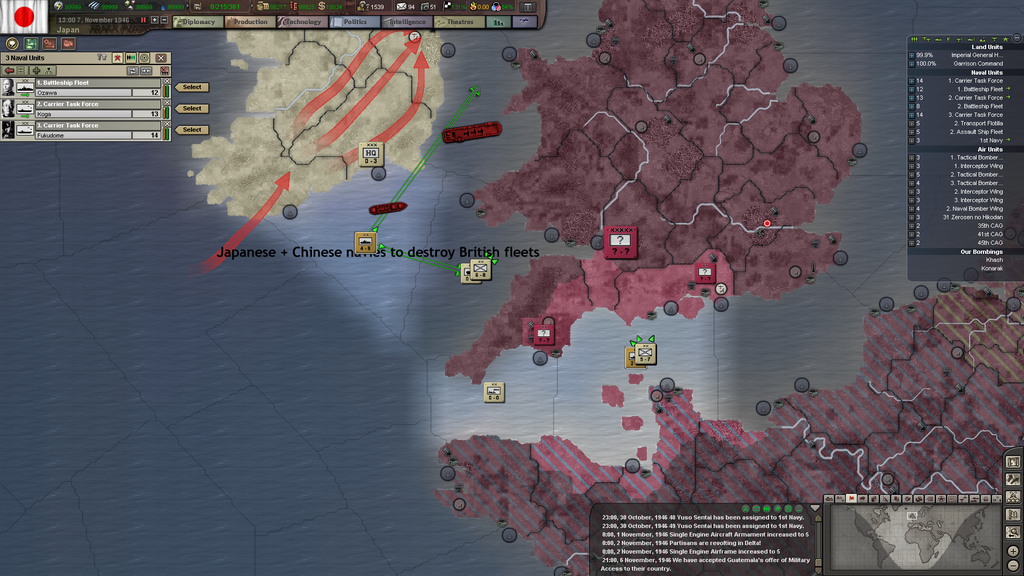Vanguards of the World's Destruction - A Nationalist China - Japan COOP AAR
Beware, the structure of this update is slightly different from useual. For chronological reasons there are 2 parts involving Sino-Japanese forces, with a look at Europe in between.
A Canadian rifleman defending a street during the battle of Washington
The summer of 1946 is one of ferocious fighting across North America as the Chinese army continues its relentless advance across the continent, backed by elite Japanese troops and covered by her mighty airforce and navy. Another invasion front has just been opened.
With a force of close to 150.000 elite marines and mountaineers, the Imperial Japanese Army has stormed ashore in Florida and seized most of the state at neckbreak speeds. Some American marines have attempted to hold the harbour of Miami, but they were driven out by superior forces, backed into a corner and forced to surrender under intense land-, naval- and air attacks in early July. The US military redeploys some of its precious divisions to halt the Florida invasion, giving Chinese troops the incentive they needed to breach the enemy lines once and for all. The final operation of the campaign has begun and none too soon.
Imperial intelligence agents report in early August that the Americans have constructed another nuclear reactor, this time in Newark, not far from New York City. The navy launches some air strikes against the facility to disrupt its production, but a planned invasion is cancelled. The marines have bigger fish to fry.
Under intense shellfire and air attack from the Japanese fleet, the major US naval base at Norfolk is taken in a combined assault by a Japanese marine corps and the Imperial Guard. The troops march north towards Washington DC under a massive screen of Japanese carrier-based aircraft. These pilots report spotting no entrenched forces around the capital at all, only a handful of American marines west of the area in Richmond and Alexandria. The Imperial guard covers the left flank of the advance and keeps these forces at bay whilst the Imperial marines surge forward to the enemy capital.
The American marines to the west have managed to find an abandoned truck depot and rushed north to support their comrades in a desperate attempt to save Washington. The Japanese imperial guard advance more rapidly however, and launch an attack against the US Marines in Alexandria before they can reach Washington. Imperial Battleships sail up the Potomac River and prepare to turn any point of resistance to rubble in an instant. Japanese aircraft carriers are based further offshore and launch waves of aircraft around the clock to spot and engage defenders on August 7th.
The Japanese marines storm into the American capital, expecting an easy conquest since the only known forces are engaged to the west. The suburbs are indeed found deserted by the Allies and 21.000 Japanese soldiers charge forward to Capitol Hill. Upon arrival they come under intense small arms fire: the area is heavily defended. With the American marine corps broken after fierce combat in the days prior, the last hope of America rests on the shoulders of just over 5.000 men of the 1st Canadian Marine Division.
Japanese marines tossing grenades prior to storming yet another Canadian fortified position in Washington
A short but bloody nighttime close quaters battle ensues as the Canadians make their stand in the Pentagon. Though they fight with zeal, the Canadians are too outnumbered and outgunned to stand a chance; the combination of naval bombardment, overwhelming numerical superiority and combat experience is just too much. As the sun rises on August 10th, Canadian officers raise the white flag over the now ruined headquaters of the US military. 93 Japanese and some 750 Canadian marines lie dead in and around the ruins of the building. In one of the offices, Imperial officers find American generals Bradley and MacArthur, commanders in chief of the US military. They surrender peacefully and offer the unconditional surrender of all United States ground forces on American soil, claiming to have lost all contact with their British allies. The offer is accepted after contacting Vanguard High Command. With the last fighting strenght of the Royal Canadian Army spend in the battle of Washington and no aid from her British allies in sight, the Canadian government decides to give up the fight 2 weeks later. August 25th, 1946 marks the end of the North American Campaign.
The European Theatre
In May 1946 the Soviet Army conquered Berlin and Austria and crossed the Italian border in a relentless onslaught. Munich fell quickly and by mid June Soviet artillery rains down on Stuttgart. The last remnants of the Wehrmacht fight for every inch of German soil and the conquest of the city turns into yet another several week urban bloodbath as the last remnants of the German army have withdrawn into the mountains north of Switserland.
The terrain might provide this part of Germany some form of protection, the rest of the country is wide open to invasion. The Red Army carves through Central Germany as fast as her tanks can roll, headed for the secret German facilities reported to have been constructed not far from the French border. The Soviets are clearly determined to get their hands on them.
Not all Soviet forces are directed there however, as scores of Soviet divisions fight their way across the Alps and into Italy during the summer months, taking advantage of the weather.
In the north the Red Army had taken Pommerania and presses forward towards the Kriegsmarine naval base at Kiel and the Danish border. By the first week of August the hammer and sickle is raised over much of Denmark and the last battered remnants of Italian blackshirts are driven from the streets of Rome by a relentless onslaught of Soviet armour. On August 17th Joseph Stalin announces the formation of the People's Republic of Denmark, followed 5 days later by the proclamation of the People's Republic of Yugoslavia. That same day the Soviet Army crosses the Hungarian and Romanian borders from the east and surprises the respective governments.
Overwhelming artillery barrages precede the Soviet Balkan Offensive
With the Balkan Axis' armies being crushed in Yugoslavia between British and Soviet forces, they are helpless to stop the invasion from the east. The Italian army collapses to the overwhelming Soviet offensive carving through the Alps and rampaging through Rome and surrenders in the morning of September 9th. Soviet and British soldiers shake hands in Greece, bringing an end to this warzone as well after years of brutal fighting.
With the fall of Italy, the war in Europe should be over any moment. Intelligence agents report Soviet tanks and infantry advancing west through Germany and northern Italy, poised to cross the French and Dutch borders and liberate these nations from the German occupation forces still present here.
The British Empire however pulls a coupe de grace.
On August 9th, tens of thousands of British infantrymen and airborne soldiers are dropped all over France and the Low Countries. The local German garrisons had already received orders to stand down and put up no resistance, happy to surrender to the British rather than the Soviets. In a fearsome speech, Winston Churchill demands the Soviet army do not cross the German western borders under threat of war. Local Soviet commanders, confused by the sudden appearance of British troops in front of them, decide to halt their operations and wait for orders. In these critical and confusing hours, the British have effectively seized control of western Europe without firing a shot.
To add to the confusion, the Vichy regime in Indochina is overthrown by communist insurgents on the 11th, leading to the area being incorporated by the Soviet Union immediatly. The Royal Hungarian Army surrenders the following day, sparing the Hungarian people a pointless battle over her lands. The Romanian army puts up valiant but futile resistance as she is forced back to Bucharest by the Soviet juggernaut. On September 27th, Soviet artilery starts raining down on the Romanian capital, which is defended by the majority of the remaining Romanian army. Simultaniously the Russian army crosses the Bulgarian border and marches on Sofia.
The siege of Bucharest is a brutal affair, with Romanian infantry conducting urban combat against the Soviet armoured columns much in the same way the Germans held the Vistula defence line earlier in the war. Ferocious house to house fighting races until October 7th, when the last surrounded Romanian regiments surrender the citadel.
The last remnants of the Axis armies retreat into Bulgaria, under attack from all sides. The British army in Greece finally launches an offensive of its own, crossing the Bulgarian border from the south. Soviet armoured columns rampage into the nation from the north without pause and smash the hastily erected barricades around Sofia. After barely 2 weeks of fighting, more thanks to the terrain than the skeleton Bulgarian forces, the capital is seized by Soviet tank forces on October 20th. British troops evacuate the country and withdraw to Greece after demands by Stalin.
Vanguard operations
Shortly after the fall of the United States, the Imperial Japanese 1. Carrier Task Force finally arrives off the coast of Persia to support her Chinese allies in halting and driving back the British armies here. Other Imperial fleets are mobilised on the American Eastcoast and form an armada ready to cross the Atlantic and the Imperial Japanese Airforce deploys patrols around Panama to hunt down and sink several enemy submarines harrassing our convoys here. They soon find and destroy several French convoy raiders.
But with Europe in chaos as the British and Soviets carve up the continent the opportunity to strike is seized. On September 25th the 2. and 3. Imperial Carrier Task Forces are ordered to cross the Atlantic Ocean, escort the Chinese divisions being transported aboard Japanese transport fleets. One fleet blocks the English Channel and another makes a run north around Scotland, looking for any remaining Allied fleets in the area. Over the next few days the last of the British destroyers and cruisers present in the Isles are sunk whilst cowering in their ports.
A week of aerial terror follows as Japanese aircraft strike Britain with impunity, ravaging airfields, depots, army bases and railways, all with barely any response from the Royal Air Force. But it is only the beginning.
The Chinese start shipping troops across the Atlantic to invade the area and Imperial naval elements continue their hunt for enemy vessels. The 3. Imperial Marine Corps is loaded onto transports and heads for Newfoundland under cover of Japanese battleships. Their orders are to seize the Brtiish bases at St John's, as well as the French port at Guadeloupe on October 20th.
4 days later the "battle" of the Celtic Sea is fought as the Royal Irish Navy attempts to run the blockade of Imperial Japanese aircraft carriers outside Dublin. It comes as no surprise that the result of this action is the destruction of the Royal Irish Navy. With this last act of suicidal bravery, Ireland surrenders to China the following day. Chinese tanks roll forward into Northern Ireland, driving the British infantry divisions that rushed to assist their neighbour back across the Irish Sea.
The offensive comes to a halt at the Irish Sea momentarily, as the British have entrenched several divisions, including tanks, on their side of the channel. Even with the aid of Imperial Japanese air attacks and marines this position would be too hard to break, so reinforcements are brought up. The final act of the war between the Vanguard armies and the British Empire is about to commence.





